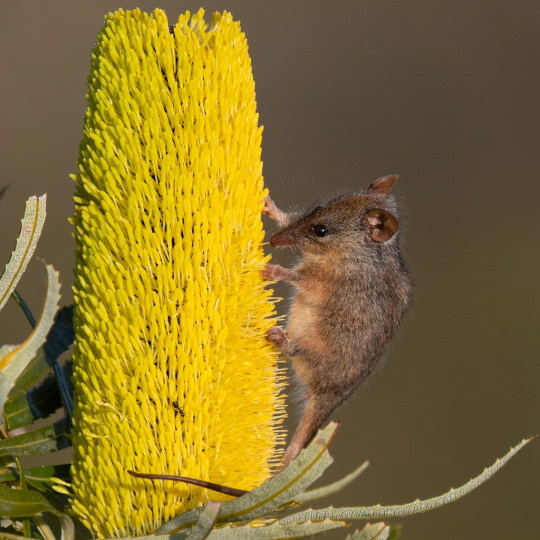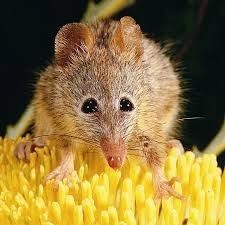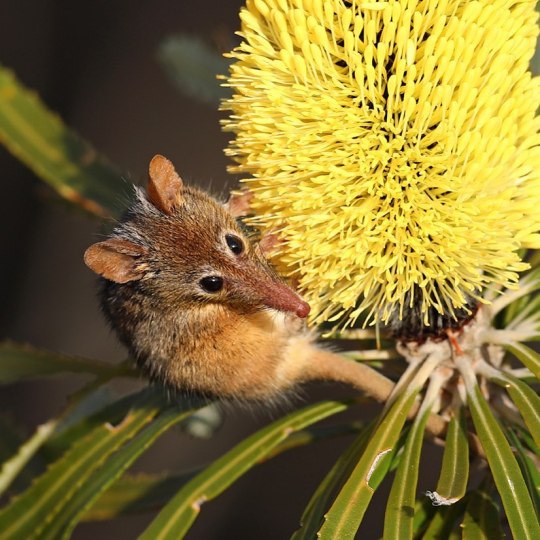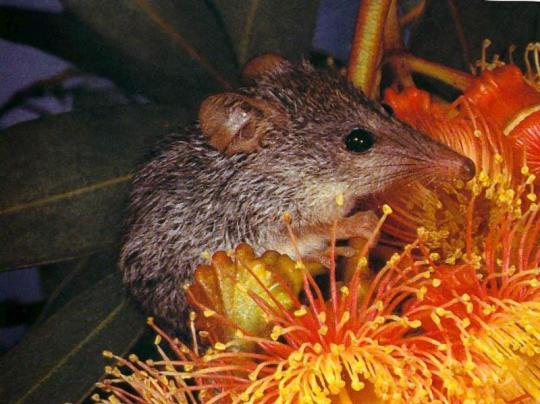#Tarsipes Rostratus
Explore tagged Tumblr posts
Photo

Honey possum (Tarsipes rostratus) drinking nectar from candlestick banksia (Banksia attenuata) flowers in Western Australia
John Anderson
3K notes
·
View notes
Text


#poll#Class: Mammalia#Order: Diprotodontia#Family: Tarsipedidae#Genus: Tarsipes#Tarsipes Rostratus#Range: Australasian
27 notes
·
View notes
Text
Honey possum (Tarsipes rostratus)

Smeeking on my flower
47K notes
·
View notes
Text

tarsipes rostratus, the honey possum, by john gould, from the mammals of australia (1863) - found on the wikimedia commons - (source)
0 notes
Photo

Honey Possum
#honey possum#Tarsipes rostratus#upl#Marsupialia#Diprotodontia#Phalangeriformes#Petauroidea#Tarsipedidae#Tarsipes
29 notes
·
View notes
Text
What is a Noolbenger?
By John Wible
Noolbenger is the Aboriginal name for the honey possum. So, what is a honey possum? A honey possum, Tarsipes rostratus, is a mouse sized marsupial found in the coastal plains of southwestern Australia. It can only survive in environments where flowers bloom 12 months of the year, because it lives entirely on nectar! They are particularly fond of Banksiaor Australian honeysuckle and are important pollinators. Some bats are also exclusively nectivorous, but their mode of locomotion (i.e., flight) allows them to have large home ranges for feeding. The honey possum accomplishes this entirely on foot at night, scampering from plant to plant. Not surprisingly, it is an adept climber with a prehensile tail acting as a fifth limb. A protrusible tongue with a keratinized brush tip is the main nectar collecting organ. Bucking the usual trend in mammals where males are larger than females, the male honey possum is roughly two-thirds the size of the female.

From John Gould’s The Mammals of Australia (1863).
The Section of Mammals of Carnegie Museum of Natural History has eight specimens of this unusual mammal, which has a very un-mammal-like skull. The bones of the skull are paper thin, reminiscent of a hummingbird skull. It has a long and pointy snout, the better to sniff flowers with. The lower jaw is essentially a thin rod. The upper and lower teeth are reduced in number and size and resemble simple translucent pegs, because you don’t need big complex teeth to grind nectar for digestion. And there is essentially no place on the skull for chewing muscle attachment, again because chewing is not mandatory for feeding.

Tarsipes rostratus, CM 111901.
Honey possums are not considered to be endangered or even threatened. So far, the major concern to their continued existence is wildfires.
John Wible, PhD, is the curator of the Section of Mammals at Carnegie Museum of Natural History. John’s research is focused on the tree of life of mammals, understanding the evolutionary relationships between living and extinct taxa, and how the mammalian fauna on Earth got to be the way it is today. He uses his expertise on the anatomy of living mammals to reconstruct the lifeways of extinct mammals. John lives with his wife and two sons in a house full of cats and rabbits in Ross Township. Museum employees are encouraged to blog about their unique experiences and knowledge gained from working at the museum.
396 notes
·
View notes
Text

Honey possum (Tarsipes rostratus)
which australian animal do you like the most, and which one makes you the most nervous??
#just a little fella#australian animals#australian marsupials#animals#mammals#marsupials#possums#honey possum#also to answer your second question: golden orb weavers skeeve me the fuck out
13 notes
·
View notes
Text
#1544 - Beaufortia incana - Grey-leaved Beaufortia



AKA Melaleuca cinerea.
Found in the Dryandra Woodlands near Lol Gray.
A shrub native to the hills and sandplains of the WA Wheatbelt, where it flowers from August to December. All Beaufortia occur in the South West Botanical Province and about half in the arid inland province. Most are found in sand plain and heath, although Beaufortia sparsa usually grows in marshy places and is known by the common name swamp bottlebrush.
The genus was first described in 1812 by Robert Brown, and named for the English gardener and botanist Mary Somerset, Duchess of Beaufort. Some taxonomists have suggested that Beaufortia along with Calothamnus, Conothamnus, Eremaea, Lamarchea, Petraeomyrtus, Phymatocarpus and Regelia (some of which I’ve covered before) should be included in the genus Melaleuca but the change has not been adopted by most herbaria. Seems to apply on iNaturalist, though.
Most species in the genus only reproduce from seed, released from the fruit after fire, and species that grow in fire-prone areas usually have a lignotuber and resprout after fire. Honeyeaters (Family Meliphagidae) and the honey possum (Tarsipes rostratus) are thought to be the main pollinators but many insects also visit the flowers.
6 notes
·
View notes
Text
Marsupials
Marsupial, any of more than 250 species belonging to the infraclass Metatheria (sometimes called Marsupialia), a mammalian group characterized by premature birth and continued development of the newborn while attached to the nipples on the mother’s lower belly. The pouch—or marsupium, from which the group takes its name—is a flap of skin covering the nipples. Although prominent in many species, it is not a universal feature. In some species the nipples are fully exposed or are bounded by mere remnants of a pouch. The young remain firmly attached to the milk-giving teats for a period corresponding roughly to the latter part of development of the fetus in the womb of a placental mammal (eutherian).
The largest and most-varied assortment of marsupials—some 200 species—is found in Australia, New Guinea, and neighbouring islands, where they make up most of the native mammals found there. In addition to larger species such as kangaroos, wallabies, wombats, and the koala (Phascolarctos cinereus), there are numerous smaller forms, many of which are carnivorous, with the Tasmanian devil (Sarcophilus harrisii) being the largest of this group (family Dasyuridae). About 70 species live in the Americas, mainly in South and Central America, but one, the Virginia opossum (Didelphis virginiana), ranges through the United States into Canada. The largest living marsupial is the red kangaroo (Macropus rufus).
The diets of marsupials are as varied as the niches they occupy. Many dasyurids live chiefly on insects and other small animals. Dunnarts (Sminthopsis) are so hyperactive—like shrews—that, in order to supply their high energy needs, they must devour their own weight in food (chiefly insects) each day. The numbat uses its remarkable wormlike tongue to lap up termites and ants. Many Australian possums, bandicoots, and American opossums have a mixed diet of plants and insects. Wombats and many other marsupials are strictly vegetarian. The small honey possum (Tarsipes rostratus) is specialized to feed on the nectar of flowers, and other marsupials also may serve as important pollinators in that way. Few large carnivores have ever evolved in Australia, because of the low productivity of its environment. The most-recent large carnivorous marsupials to evolve—the Tasmanian devil and the now-extinct thylacine, or Tasmanian wolf (Thylacinus cynocephalus)—were both displaced on the mainland by the dingo.
Marsupials are notably less intelligent than placental mammals, partly because of their simpler brains. Compared with that of placentals, the brain of marsupials differs markedly in both structure and bulk. Most notably, it lacks a corpus callosum, the part of the placental brain that connects the two cerebral halves. The marsupial brain is also smaller relative to overall body size; for example, a quoll has about half as much brain tissue as a placental cat of similar skull size. It is not surprising, therefore, to find that marsupial behaviour differs somewhat from that of placentals. One peculiarity that may stem from that underdevelopment is restricted vocal ability. Although marsupials are not entirely silent, few emit loud sounds of excitement or distress; apparently, none utters grunts of contentment or even cries of hunger when young. Their vocalizing is more limited and less variable than that of placentals. The ferocious-sounding rutting roars of male koalas are a dramatic and unexpected exception.

0 notes
Photo










The mammals of Australia. By Gould, John. London, Printed by Taylor and Francis, pub. by the author,1863. (V.1 1863) @BioDivLibrary https://www.biodiversitylibrary.org/bibliography/112962#/summary … -
- Ornithorhynchus anatinus
- Echidna hystryx
- Echidna setosa
- Myrmecobius fasciatus
- Tarsipes rostratus
- Choeropus catanotis
- Peragalea lagosti
- Perameles fasciata
- Perameles gunnil
- Perameles myosurus
1 note
·
View note
Text
Honey Possum
Scientific Name: Tarsipes rostratus

On the southernmost corner of Australia, a mouse sizes marsupial can be found known as the Tarsipes rostratus, or Honey Possum. The little brown and gray marsupial has lived alongside the indigeneous people for thousands of years and has developed many names, including honey possum and mouse.
It feeds itself by drinking the nectar from flowers with its specialized elongated snout. Despite its name, the honey possum is only vaguely related to possums and more closely related to possum like marsupials from Chile and South America.
Fun Fact #1: Ancestors of the early honey possum can be found as far away as Antartica.

DNA studies suggest that the Honey Possum evolved from a small possum-like marsupial from Chile in South America, and can even further be linked to microbiotheriid fossils discovered in South America, Antarctica and South Australia. Experts say that the honey possum's ancestors were stuck on the Austrailian continent after it drifted away from the large southern land mass named Gondwana, and since then has developed into the modern honey possum, or the noolbenger, as it is called by the land's indigenous people.

The honey possum may be found on coastal sand plains and heaths, where its diet consists mostly of the nectar from flowers. In a day, this mouse sized marsupial may drink twice of its body weight in nectar. This makes it a key component in south west Australia's ecosystem, which relies heavily on the little honey possum to carry pollen on its face from flower to flower.
Fun Fact #2: Although it is hardly a possum, Tarsipes rostratus has evolved to curl its tail around branches and hang vertically upside down.
The reproductive systems of Honey Possums are very unusual. Male honey possums, who are signifigantly smaller than their female counterparts, have large testes making up 4.2% of their body weight. Meanwhile, the female's eggs, which are otherwise standard for a mammal, may be fertilized by multiple males.
Here is the Taxonomy of Tarsipes rostratus:
Kingdom: Animalia Phylum: Chordata Class: Mammalia Order: Diprotodontia Family: Tarsipedidae Genus: Tarsipes Species: rostratus

3 notes
·
View notes
Photo



Honey-possum (Tarsipes rostratus) Also known as: Tait, noolbenger
The honey-possum is one of the very few entirely nectarivorous mammals; it has a long, pointed snout and a long, protrusible tongue with a brush tip that gathers pollen and nectar, like a hummingbird. Floral diversity is particularly important for the honey possum, as it cannot survive without a year-round supply of nectar and, unlike nectarivorous birds, it cannot easily travel long distances in search of fresh supplies. Although restricted to a fairly small range in the southwest of Western Australia, it is locally common and does not seem to be threatened with extinction so long as its habitat remains intact and diverse.
Classification Animalia - Chordata - Mammalia - Metatheria - Marsupialia - Australidelphia - Diprotodontia - Phalangeriformes - Petauroidea - Tarsipedidae - Tarsipes - T. rostratues
Images: [x] [x] [x] Source: [x]
#least concern#honey possum#tait#noolbenger#tarsipes rostratus#tarsipes#tarsipedidae#petauroidea#phalangeriformes#diprodontia#australidelphia#marsupialia#metatheria#species feature#mammalia#tetrapoda#vertebrata#chordata
24 notes
·
View notes
Text
Honey Possum
Tarsipes rostratus
Tarsipes is in reference to their ankles, while rostratus means curved snout..
Family: Tarsipedidae (only species of Honey Possum)
Fun Fact: “Honey possums are important pollinators for a number of different plants and are the principle pollinators of nodding banksia (Banksia nutans), which is common on the southern coast of Western Australia.” (ADW)
Habitat: They are endemic to woodlands and scrub forests of the southwestern tip of Western Australia.
Ecosystem Role: They act as pollinators feeding on nectar and pollen. They provide food for birds of prey (like owls, kestrels, and kites), reptiles (including the tiger snake and southern monitor), and invasive animals like red foxes and house cats.
Conservation Status: Least Concern
1 note
·
View note
Photo

Honey possum (Tarsipes rostratus)
The honey possum is a tiny Australian marsupial. Male honey possums weigh just 7 to 11 g, and females weigh 8 to 16 g; about half the weight of a mouse. Their body length ranges from 6.5 to 9 cm. It is one of the very few entirely nectarivorous mammals; it has a long, pointed snout and a long, protrusible tongue with a brush tip that gathers pollen and nectar, like a honeyeater or a hummingbird. Floral diversity is particularly important for the honey possum, as it cannot survive without a year-round supply of nectar and, unlike nectarivorous birds, it cannot easily travel long distances in search of fresh supplies. Although restricted to a fairly small range in the southwest of Western Australia, it is locally common and does not seem to be threatened with extinction so long as its habitat of heath, shrubland, and woodland remains intact and diverse. The honey possum is mainly nocturnal, but will come out to feed during daylight in cooler weather. Generally, though, it spends the days asleep in a shelter of convenience: a rock cranny, a tree cavity, the hollow inside of a grass tree, or an abandoned bird nest.
photo credits: Meta Boom
#honey possum#tarsipes rostratus#possum#zoology#biology#biodiversity#science#wildlife#nature#animals#cool critters
217 notes
·
View notes
Photo

“Honey Possum.” Colored pencil and acrylic on art board.
Purchase here:
http://www.redbubble.com/people/angieschlauch/works/14841462-honey-possum?p=poster&ref=work_main_nav
#honey possum#Tarsipes rostratus#eucalyptus macrocarpa#mottlecah#australia#australian fauna#marsupial#mammal#eucalyptus#flower
8 notes
·
View notes
Photo


These are the cutest things in Australia!
12 notes
·
View notes